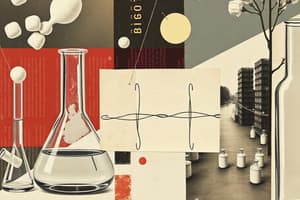Podcast
Questions and Answers
What is the main characteristic that defines carbohydrates?
What is the main characteristic that defines carbohydrates?
- Presence of amine groups
- Presence of multiple hydroxyl groups (correct)
- Presence of carboxyl groups
- Presence of methyl groups
What is the purpose of the Fischer projection in carbohydrate representation?
What is the purpose of the Fischer projection in carbohydrate representation?
- To show the molecular formula of carbohydrates
- To show the branching of carbohydrates
- To show the ring structure of carbohydrates
- To show the absolute configuration of monosaccharides (correct)
What is the term for the process by which a monosaccharide changes from an α-anomer to a β-anomer?
What is the term for the process by which a monosaccharide changes from an α-anomer to a β-anomer?
- Cyclization
- Hemiacetal formation
- Mutarotation (correct)
- Epimerization
What type of bond is formed during the cyclization of carbohydrates?
What type of bond is formed during the cyclization of carbohydrates?
What is the term for a pair of non-superimposable mirror images of a monosaccharide?
What is the term for a pair of non-superimposable mirror images of a monosaccharide?
What is the term for a monosaccharide with a chain length of 3-7 carbon atoms?
What is the term for a monosaccharide with a chain length of 3-7 carbon atoms?
What is the primary function of carbohydrates as a source of energy?
What is the primary function of carbohydrates as a source of energy?
What is the classification of sucrose, lactose, and maltose?
What is the classification of sucrose, lactose, and maltose?
What is the role of carbohydrates in the structural materials of cells?
What is the role of carbohydrates in the structural materials of cells?
What is the result of hydrolyzing oligosaccharides?
What is the result of hydrolyzing oligosaccharides?
What is the function of carbohydrates in glycoproteins and glycolipids?
What is the function of carbohydrates in glycoproteins and glycolipids?
What is the classification of glucose, mannose, galactose, fructose, and ribose?
What is the classification of glucose, mannose, galactose, fructose, and ribose?
Study Notes
Carbohydrate Structure and Functions
Definition and Representation
- Carbohydrates are aldehyde or ketone compounds with multiple hydroxyl groups.
- They can be represented by chemical formulae, Fischer projection, and Haworth projection.
Roles of Carbohydrates in Nature
- Fuel source: important source of energy when oxidized
- Energy storage: starch in plants; glycogen in liver and muscle of animals
- Structural materials: DNA and RNA, cell walls of bacteria and plants; chitin in exoskeleton
- Intermediates of metabolism
- Recognition: glycoproteins and glycolipids act as markers for cellular recognition, blood group determination, cell adhesion, cell migration, immune response, and blood clotting
Classification of Carbohydrates
Monosaccharides
- Cannot be hydrolyzed into simpler sugars
- Examples: glucose, mannose, galactose, fructose, and ribose
Disaccharides
- Hydrolysis yields 2 monosaccharides (sugars)
- Examples: sucrose, lactose, maltose, cellubiose, and gentiobiose
Oligosaccharides (Few Sugars)
- Hydrolysis produces >2 but (<10) monosaccharides
Important Carbohydrates
Composition and Bonding
- Lactose: composed of glucose and galactose; α-1,4-glycosidic bond
- Maltose: composed of two glucose molecules; α-1,4-glycosidic bond
- Sucrose: composed of glucose and fructose; α-1,2-glycosidic bond
- Starch, glycogen, cellulose, and chitin: composed of multiple glucose molecules; α-1,4-glycosidic bonds
Stereochemistry
- Enantiomers: non-superimposable mirror images
- Diastereoisomers: stereoisomers that are not enantiomers
- Anomers: stereoisomers that differ in configuration at the anomeric carbon
- Epimers: stereoisomers that differ in configuration at a single carbon atom
- D and L stereoisomers of glyceraldehyde
- Fischer projection and Haworth projection of D-glucose
Cyclization and Anomers
- Cyclization arises through the formation of hemiacetal and hemiketal bonds
- Mutarotation: change in anomeric configuration over time
- α- and β-anomers of monosaccharides
Reducing and Non-Reducing Sugars
- Sugars with a free aldehyde or ketone group are reducing sugars
- Examples of reducing sugars: glucose, fructose, and lactose
- Examples of non-reducing sugars: sucrose
Studying That Suits You
Use AI to generate personalized quizzes and flashcards to suit your learning preferences.
Description
This quiz covers the structure and functions of carbohydrates, including their representation by chemical formulae, Fischer and Haworth projections, and their roles in nature. Learn about the classification of carbohydrates into mono-, di-, oligo- and polysaccharides.




